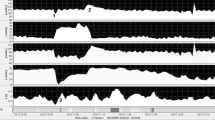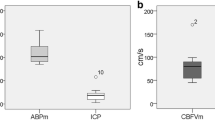Abstract
Background
Critical closing pressure (CCP) denotes a threshold of arterial blood pressure (ABP) below which brain vessels collapse and cerebral blood flow ceases. Theoretically, CCP is the sum of intracranial pressure (ICP) and arterial wall tension (WT). The aim of this study is to describe the behavior of CCP and WT during spontaneous increases of ICP, termed plateau waves, in order to quantify ischemic risk.
Methods
To calculate CCP, we used a recently introduced multi-parameter method (CCPm) which is based on the modulus of cerebrovascular impedance. CCP is derived from cerebral perfusion pressure, ABP, transcranial Doppler estimators of cerebrovascular resistance and compliance, and heart rate. Arterial WT was estimated as CCPm-ICP. The clinical data included recordings of ABP, ICP, and transcranial Doppler-based blood flow velocity from 38 events of ICP plateau waves, recorded in 20 patients after head injury.
Results
Overall, CCPm increased significantly from 51.89 ± 8.76 mmHg at baseline ICP to 63.31 ± 10.83 mmHg at the top of the plateau waves (mean ± SD; p < 0.001). Cerebral arterial WT decreased significantly during plateau waves by 34.3 % (p < 0.001), confirming their vasodilatatory origin. CCPm did not exhibit the non-physiologic negative values that have been seen with traditional methods for calculation, therefore rendered a more plausible estimation of CCP.
Conclusions
Rising CCP during plateau waves increases the probability of cerebral vascular collapse and zero flow when the difference: ABP–CCP (the “collapsing margin”) becomes zero or negative.





Similar content being viewed by others
References
Lundberg N. Continuous recording and control of ventricular fluid pressure in neurosurgical practice. Acta Psychiatr Scand Suppl. 1960;36(149):1–193.
Rosner MJ, Becker DP. Origin and evolution of plateau waves. Experimental observations and a theoretical model. J Neurosurg. 1984;60(2):312–24.
Hayashi M, Handa Y, Kobayashi H, Kawano H, Ishii H, Hirose S. Plateau-wave phenomenon (I). Correlation between the appearance of plateau waves and CSF circulation in patients with intracranial hypertension. Brain. 1991;114(Pt 6):2681–91.
Hayashi M, Kobayashi H, Handa Y, Kawano H, Kabuto M. Brain blood volume and blood flow in patients with plateau waves. J Neurosurg. 1985;63(4):556–61.
Castellani G, Zweifel C, Kim DJ, Carrera E, Radolovich DK, Smielewski P, Hutchinson PJ, Pickard JD, Czosnyka M. Plateau waves in head injured patients requiring neurocritical care. Neurocrit Care. 2009;11(2):143–50.
Czosnyka M, Smielewski P, Piechnik S, Schmidt EA, Al-Rawi PG, Kirkpatrick PJ, Pickard JD. Hemodynamic characterization of intracranial pressure plateau waves in head-injury patients. J Neurosurg. 1999;91(1):11–9.
Hayashi M, Kobayashi H, Kawano H, Yamamoto S, Maeda T. Cerebral blood flow and ICP patterns in patients with communicating hydrocephalus after aneurysm rupture. J Neurosurg. 1984;61(1):30–6.
Risberg J, Lundberg N, Ingvar DH. Regional cerebral blood volume during acute transient rises of the intracranial pressure (plateau waves). J Neurosurg. 1969;31(3):303–10.
Hayashi M, Kobayashi H, Kawano H, Handa Y, Yamamoto S, Kitano T. ICP patterns and isotope cisternography in patients with communicating hydrocephalus following rupture of intracranial aneurysm. J Neurosurg. 1985;62(2):220–6.
Avezaat CJJ, van Eijndhoven JHM. Cerebrospinal fluid pulse pressure and craniospinal dynamics. A theoretical clinical and experimental study. Thesis. The Hague: A Jongbloed; 1984.
Rosner MJ. Pathophysiology and management of increased intracranial pressure. Care: Neurosurg Int; 1999. p. 57–112.
Matsuda M, Yoneda S, Handa H, Gotoh H. Cerebral hemodynamic changes during plateau waves in brain-tumor patients. J Neurosurg. 1979;50(4):483–8.
Gjerris F, Borgesen SE, Hoppe E, Boesen F, Nordenbo AM. The conductance to outflow of CSF in adults with high-pressure hydrocephalus. Acta Neurochir (Wien). 1982;64(1–2):59–67.
Batorski L, Czosnyka M, Laniewski P, Zaworski W. Application of advanced forms of intracranial pressure analysis in craniosynostosis. In: Hoff JT, Betz AL, editors. Intracranial pressure, vol. VII. Berlin/Heidelberg/New York: Springer-Verlag; 1989. p. 189–92.
Renier D, Sainte-Rose C, Marchac D, Hirsch JF. Intracranial pressure in craniostenosis. J Neurosurg. 1982;57(3):370–7.
Czosnyka M, Pickard JD. Monitoring and interpretation of intracranial pressure. J Neurol Neurosurg Psychiatry. 2004;75:813–21.
Schmidt B, Czosnyka M, Schwarze JJ, Sander D, Gerstner W, Lumenta CB, Pickard JD, Klingelhofer J. Cerebral vasodilatation causing acute intracranial hypertension: a method for noninvasive assessment. J Cereb Blood Flow Metab. 1999;19(9):990–6.
Burton AC. Fundamental instability of the small blood vessels and critical closing pressure in vascular beds. Am J Physiol. 1951;164:330–1.
Brunner MJ, Greene AS, Sagawa K, Shoukas AA. Determinants of systemic zero-flow arterial pressure. Am J Physiol 1983;245:H453–9.
Czosnyka M, Smielewski P, Piechnik S, Al-Rawi PG, Kirkpatrick PJ, Matta BF, Pickard JD. Critical closing pressure in cerebrovascular circulation. J Neurol Neurosurg Psychiatry. 1999;66:606–11.
Panerai RB. The critical closing pressure of the cerebral circulation. Med Eng Phys. 2003;25:621–32.
Dewey RC, Pierer HP, Hunt WE. Experimental cerebral hemodynamics-Vasomotor tone, critical closing pressure, and vascular bed resistance. J Neurosurg. 1974;41(5):597–606.
López-Magaña JA, Richards HK, Radolovich DK, Kim DJ, Smielewski P, Kirkpatrick PJ, Pickard JD, Czosnyka M. Critical closing pressure: comparison of three methods. J Cereb Blood Flow Metab. 2009;29(5):1–7.
Panerai RB, Salinet AS, Brodie FG, Robinson TG. Influence of calculation method on estimates of cerebral critical closing pressure. Physiol Meas. 2011;32:1–16.
Ursino M, Di Giammarco P. A mathematical model of the relationship between cerebral blood volume and intracranial pressure changes: the generation of plateau waves. Ann Biomed Eng. 1991;19(1):15–42.
Richards HK, Czosnyka M, Pickard JD. Assessment of critical closing pressure in the cerebral circulation as a measure of cerebrovascular tone. Acta Neurochir (Wien). 1999;141(11):1221–7.
Aaslid R, Lash SR, Bardy GH, Gild WH, Newell DW. Dynamic pressure–flow velocity relationships in the human cerebral circulation. Stroke. 2003;34(7):1645–9.
Michel E, Hillebrand S, von Twickel J, Zernikow B, Jorch G. Frequency dependence of cerebrovascular impedance in preterm neonates: a different view on critical closing pressure. J Cereb Blood Flow Metab. 1997;17:1127–31.
Puppo C, Camacho J, Yelicich B, Moraes L, Biestro A, Gomez H. Bedside study of cerebral critical closing pressure in patients with severe traumatic brain injury: a transcranial Doppler study. Acta Neurosurg Suppl. 2012;114:283–8.
Varsos GV, Richards H, Kasprowicz M, Budohoski KP, Brady KM, Reinhard M, Avolio M, Smielewski P, Pickard JD, Czosnyka M. Critical closing pressure determined with a model of cerebrovascular impedance. J Cereb Blood Flow Metab. 2012;33(2):235–43.
Kim DJ, Kasprowicz M, Carrera E, Castellani G, Zweifel C, Lavinio A, Smielewski P, Sutcliffe MP, Pickard JD, Czosnyka M. The monitoring of relative changes in compartmental compliances of brain. Physiol Meas. 2009;30(7):647–59.
de Riva N, Budohoski KP, Smielewski P, Kasprowicz M, Zweifel C, Luzius A, Reinhard M, Fabregas N, Pickard JD, Czosnyka M. Transcranial Doppler pulsatility index: what it is and what it isn’t. Neurocrit Care. 2012;17(1):58–66.
Czosnyka M, Richards HK, Reinhard M, Steiner AL, Budohoski K, Smielewski P, Pickard JD, Kasprowicz M. Cerebrovascular time constant: dependence on cerebral perfusion pressure and end-tidal carbon dioxide concentration. Neurol Res. 2012;34(1):17–24.
Kasprowicz M, Czosnyka M, Soehle M, Smielewski P, Kirkpatrick PJ, Pickard JD, Budohoski KP. Vasospasm shortens cerebral arterial time constant. Neurocrit Care. 2011;16(2):213–8; ISSN 1541-6933.
Carrera E, Kim DJ, Castellani G, Zweifel C, Smielewski P, Pickard JD, Kirkpatrick PJ, Czosnyka M. Cerebral arterial compliance in patients with internal carotid artery disease. Eur J Neurol. 2010;18:711–8.
Soehle M, Czosnyka M, Pickard JD, Kirkpatrick PJ. Critical closing pressure in subarachnoid hemorrhage: effect of cerebral vasospasm and limitations of a transcranial Doppler-derived estimation. Stroke. 2004;35(6):1393–8.
Gazzoli P, Frigerio M, De Peri E, Rasulo F, Gasparotti R, Lavinio A. Latronico N.A case of negative critical closing pressure. Abstracts of the 8th international conference on Xenon CT and related cerebral blood flow techniques: cerebral blood flow and brain metabolic imaging in clinical practice. Br J Neurosurg. 2006;20:348.
Daley ML, Leffler CW, Czosnyka M, Pickard JD. Plateau waves: changes of cerebrovascular pressure transmission. Acta Neurochir Suppl. 2005;95:327–32.
Acknowledgments
This study was supported by the National Institute of Health Research, Biomedical Research Centre (Neuroscience Theme), NIHR Senior Investigator Awards (JDP) and the Medical Research Council (Grants G0600986 and G9439390).
Conflict of interest
ICM+ Software is licensed by Cambridge Enterprise, Cambridge, UK, http://www.neurosurg.cam.ac.uk/icmplus/. MC and PS have a financial interest in a fraction of the licensing fee.
Author information
Authors and Affiliations
Corresponding author
Rights and permissions
About this article
Cite this article
Varsos, G.V., de Riva, N., Smielewski, P. et al. Critical Closing Pressure During Intracranial Pressure Plateau Waves. Neurocrit Care 18, 341–348 (2013). https://doi.org/10.1007/s12028-013-9830-5
Published:
Issue Date:
DOI: https://doi.org/10.1007/s12028-013-9830-5




